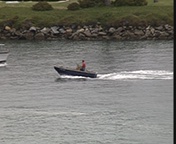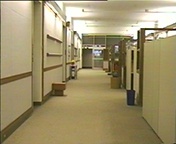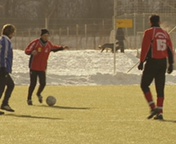Test Conditions
This web page reports the detailed evaluation of the DISCOVER monoview video codec. However, in order to evaluate the DISCOVER codec and facilitate future comparisons against its RD performance it is essential to precisely define the performance evaluation conditions and the video codec control parameters.
Only the luminance component is coded and thus all metrics (e.g. PSNR) refer only to the luminance.
Test Material
The monoview test material used and some relevant test conditions are described in the following:
- Sequences: Foreman (with the Siemens logo), Hall Monitor, Coast Guard, and Soccer
- Frames: all frames, this means 299 for Foreman, 329 for Hall Monitor, 299 for Coast guard, and 299 for Soccer.
- Spatial resolution: QCIF
- Temporal resolution: 15 Hz which means 7.5 Hz for the WZ frames when GOP=2 is used.
- GOP length: 2 (if not otherwise indicated), 4 and 8.
Since sometimes there are multiple versions of the same sequence (e.g. with different spatial or temporal subsampling filters) you can download each sequence here (already downsampled @ 15Hz):
The sequences at 30Hz can be found here: Foreman, Hall Monitor, Coast Guard, and Soccer
Quantization
In DISCOVER codec, eight rate-distortion points are considered most of the times, corresponding to the various 4×4 quantization matrices depicted here:
|
|
|
|
||||||||||||||||||||||||||||||||||||||||||||||||||||||||||||||||
|---|---|---|---|---|---|---|---|---|---|---|---|---|---|---|---|---|---|---|---|---|---|---|---|---|---|---|---|---|---|---|---|---|---|---|---|---|---|---|---|---|---|---|---|---|---|---|---|---|---|---|---|---|---|---|---|---|---|---|---|---|---|---|---|---|---|---|---|
| Qi = 1 | Qi = 2 | Qi = 3 | Qi = 4 | ||||||||||||||||||||||||||||||||||||||||||||||||||||||||||||||||
|
|
|
|
||||||||||||||||||||||||||||||||||||||||||||||||||||||||||||||||
| Qi = 5 | Qi = 6 | Qi = 7 | Qi = 8 |
Within a 4×4 quantization matrix, the value at position k indicates the number of quantization levels associated to the DCT coefficients band b(k); the value 0 means that no Wyner-Ziv bits are transmitted for the corresponding band.
The various matrices will be referred as Qi with i= 1, …, 8; the higher is Qi, the higher are the bitrate and the quality.
Slepian-Wolf Codec
In order to perform Slepian-Wolf coding the rate-compatible LDPC Accumulate (LDPCA) codes, which have been introduced in [1], are used. The performance of LDPCA codes are shown to be better than those of turbo codes for moderate and high rates, for the distributed video coding case.
Side Information Creation Process
The creation of the side information has been described in detail in [2]. The most important control parameters related to the frame interpolation in the side information creation process are presented:
- Two block sizes are used: 16×16 and 8×8.
- The forward motion estimation works with 16×16 block size and ±32 pixels are used for the search range.
- In the second iteration, the motion vectors are refined using 8×8 block sizes and an adaptive search range is used.
- The motion search is performed using the half-pixel precision.
- The reference frames are first low pass filtered with the mean filter with 3×3 mask size.
Key Frames Coding
The key frames are always encoded with H.264/AVC Intra (Main profile) since this is the best performing Intra video coding standard available. The key frames quantization steps have been found using an iterative process which stops when the average quality (PSNR) of the WZ frames is similar to the quality of the Intra frames (H.264/AVC encoded). The selection of these QP values for the key frames was made with the target to have almost constant decoded video quality for the full set of frames (key frames and WZ frames). It is important to note that investing the same total bitrate in a different way between WZ and key frames may lead to a better RD performance, for example by investing more bits in the key frames, at the cost of a less stable video quality. This is a choice to be made by the encoder knowing the consequences in terms of subjective impact. The key frames are coded with constant quantization parameters and have been obtained for GOP = 2, QCIF@15 Hz as defined in:
| Q1 | Q2 | Q3 | Q4 | Q5 | Q6 | Q7 | Q8 | |
|---|---|---|---|---|---|---|---|---|
| Foreman | 40 | 39 | 38 | 34 | 34 | 32 | 29 | 25 |
| Hall Monitor | 37 | 36 | 36 | 33 | 33 | 31 | 29 | 24 |
| Coastguard | 38 | 37 | 37 | 34 | 33 | 31 | 30 | 26 |
| Soccer | 44 | 43 | 41 | 36 | 36 | 34 | 31 | 25 |
References
1. D. Varodayan, A. Aaron and B. Girod, “Rate-Adaptive Codes for Distributed Source Coding”, EURASIP Signal Processing Journal, Special Issue on Distributed Source Coding, pp. 3123 - 3130, vol. 86, nº 11, Nov. 2006.
2. X. Artigas, J. Ascenso, M. Dalai, S. Klomp, D. Kubasov, M. Ouaret, "The DISCOVER codec: Architecture, Techniques and Evaluation", Picture Coding Symposium 2007, Lisbon, Portugal.



